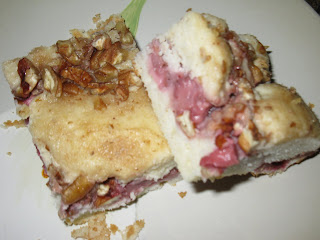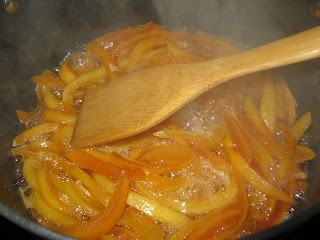I know that cooking "green" may seem like a weird concept, but it's really all about saving energy and water. I'll also include some thoughts and links here for saving on groceries.
Perhaps the greenest thing you can do in your kitchen is to make conscious choices about perceived waste. As I mentioned in yesterday's post, we compost everything we can. This included the usual organic material (fruit pulp, veggie scraps that won't work for stock, egg shells), but we also compost shredded paper towels (that don't have cleaning products on them), and put spent coffee grounds and tea bags in the garden we're preparing for the blueberries (since they're acid loving plants). In addition to composting, I make our own vegetable stock using veggie scraps. This idea came to me several years ago after reading through what has become one of our favorite cookbooks,
Cheap, Fast, Good. The method is described in detail there, but basically, we save veggie scraps (carrot peelings, celery ends, herbs close to being spent, onion ends, etc.) in a freezer bag and cook them with water in the crockpot when the bag is full. We usually get about 8 cups from a gallon of scraps, after we've strained it. Then, we freeze the stock. And, of course, we recycle whatever we can of the packaging.
When we begin thinking about cooking, we make a weekly plan. Sometimes this is on paper, sometimes it's just a conversation. We try to make use of what we already have on hand and include at least two vegetarian meals a week. (Vegetarian meals take less energy and water in the production of the food itself than meals that use meat, where much of the corn we grow in this country serves as fodder for livestock. Vegetarian meals, especially if they include a complete protein of nuts/beans and grain, can be even more healthful than meals including meat, and are generally cheaper.) When we plan meals that use meat, we try to stretch the meat we're using by incorporating it into a stir fry, casserole, or soup. Making a weekly plan means that we only go to the store once, or not at all, during the week, meaning that we're spending less in fuel and saving the use of fossil fuels.
We also try to choose meals that we can cook a lot and then eat the leftovers for a few days or freeze them. This means that we're using less energy daily, saving our electricity bill and the planet from coal burning byproducts. This week, for example, we cooked our Valentine's meal of steak, baked potatoes, and sugar snap peas on Sunday, but cooked a lot, so that we could reheat it later for lunches or dinner. We also made a lasagna, incorporating spinach, fresh organic Italian parsley, sausage, marinara sauce, and cheese, meaning that we got all of our minerals and nutrients in one casserole. Since we used the smaller oven for this, we were using less energy, and reheating in the microwave takes a fraction of what it would take to reheat in the oven. We've done a lot of various soups lately, so we're kind of "souped" out. However, some of our favorite soup recipes come from the earlier cookbook mentioned,
More with Less, and the magazine
Everyday with Rachel Ray (thanks for that subscription, Mom).
When we are cooking, vs. reheating, we do our best to steam veggies and shrimp, as it requires less water and can be done in the microwave more efficiently than boiling on the stove. When we do have to boil things, such as pasta, we make sure the heat is turned down as low as possible for a boil and the lid is on. This means that we have to watch the pot a little more closely (yes, we've had some gigantic messes with boiled over water or milk when making soup or shrimp and grits), but ultimately, we're saving energy and often time, by covering the pot. When we stir fry, we use a large, heavy skillet so that we can fit a lot in and it will conduct heat evenly. We start with what will take the longest and move to the quickest cooking ingredients, so we're not having to clean out the pan.
Now for the part that most of you were wanting, probably... what is our savings strategy? Our monthly budget for groceries ranges from $100-$150, depending on how depleted our stockpile is. (This includes all toiletries, paper products, etc.) This means that we watch sales and coupons closely, primarily using the Grocery Game (www.thegrocerygame.com). (This is a service we pay for, but feel that it's worth it because it takes a lot of the time out of it for us, matching sales and coupons. If you decide to sign up for this service, please list me as your referral and use my arpurser@earthlink.net email address. With every three referrals, we get some months free, which would help us stretch things a bit more.) With this service, we manage to save usually 50% or more on a grocery trip, since Harris Teeter doubles coupons on a regular basis. We try not to buy too many processed foods, knowing that there's a lot of stuff in them that isn't good for us and there are just empty calories in much of that food. Most of our food we make from scratch, so we rely heavily on fresh organic produce (which we grow or purchase at the farmer's market when it's open), whole grains (wild rice, quinoa, barley, whole wheat pasta and flour), and meat (we try to purchase beef from Jason Brooks at the farmer's market). We also make every effort to buy organic dairy products when they are on sale, although this doesn't happen all the time. We do purchase fresh goat cheese from our dear friend Liza at the farmer's market. (http://www.ripshingoatdairy.com/ it's amazing stuff!) Some friends (kudos to Ben and Beth) recently told us about the coupon books at the front of EarthFare, so those will help us stick to this more. Another friend (awesome, Heather) recently started a blog on couponing (http://clippingcouponssavingdollars.blogspot.com/) which has been a great resource.
We've begun making all of our own bread using the bread machine given to us by a friend (thanks Maggie!), which is nice because it costs less per loaf for the basic ingredients than buying store bought, and we know that the bread doesn't have all of those preservatives in it like store bought bread does. It also means that we can create unique flavor combinations, like the beer bread I've made recently, as well as the pumpkin carrot loaf I made a few weeks ago. Making our own bread also makes breakfasts easy, meaning that we don't rely as much on store bought cereals, but can instead have toast with homemade jam or jelly. And, it's a wonderful gift for people and so appreciated.
A wonderful friend, Don Cox (aka Bald Guy at www.baldguybrew.com), roasts coffee locally that is fair trade and organic and truly sees his business as the mission field. We try to support him and have been able to work out some bartering over the years (I painted the mural in his kids room, Benny supplied him with primer for his new home), thus keeping our coffee costs low. It's nice knowing that bartering is still alive and well in Watauga County! And it's wonderful to know that we are supporting a family business that has an impact on the earth and global community. Bald Guy will ship his coffee to you and has shipped it all over the U.S., so if you're interested in trying his coffee, you can order from his website. He sells it whole bean or ground, and rounds his pounds up, unlike the grocery store varieties, which often are only 10-12 oz.
Finally, we try to grow and harvest what we can from our land. Since we just moved into the house a little over a year ago, we don't have a lot established, aside from what nature had already started. We are blessed to have apple trees, blackberry bushes, and dandelions (yes, you can absolutely eat the greens as long as you rinse them well). As I mentioned yesterday, we're starting a community garden with our small group this spring, as well as planting raspberries, blueberries, and hazelnuts that will produce for years to come if we take care of them well. We'll add to our herbs this year, to have chives, mint, lemon balm, thyme, parsley, oregano, basil, and hopefully cilantro and rosemary. (And of course, we'll have lavender. More on this love later.) We're consulting with another friend this week on raising chickens, which will provide us with fresh eggs and wonderful manure as compost. They will also help to keep the insect pests low (hopefully including those awful Asian lady beetles that they drop on the local tree farms). Benny is also contemplating taking a bee keeping course through the local agricultural extension agency so that we can help bring the bee population back (yay for natural pollinators) and have honey to use in baked goods and tea. One of our primary goals with all of this gardening is to become more self sufficient, making our carbon footprint smaller by not having produce trucked or flown around the world to make it to our kitchen table. If you're interested in this, check out local food movements in your area. Most areas today have fantastic farmer's markets and some farms offer CSA's, meaning that you can purchase a share in the farm to support their business in exchange for an agreed upon amount of produce on a regular basis.
I hope you've found some helpful information in today's post and will let us know what you'd like to see us explore further. If you have any questions or want more detail about anything in the post today, leave a comment and I'll get back to you!
 I made it for my cousin's wedding breakfast at the beach a few years ago, and it was a total hit! I used strawberries I had frozen a while back, and it was good, but is much better with field fresh strawberries. So, I've included a picture here of our lovely, buttery, cream cheesy (no that's probably not a word, but go with it), HEAVENLY coffee cake. (Did I mention how good this stuff is?!) It's great slightly warm with a cup of coffee. So, here's the recipe from Coffee Cakes by Lou Seibert Pappas:
I made it for my cousin's wedding breakfast at the beach a few years ago, and it was a total hit! I used strawberries I had frozen a while back, and it was good, but is much better with field fresh strawberries. So, I've included a picture here of our lovely, buttery, cream cheesy (no that's probably not a word, but go with it), HEAVENLY coffee cake. (Did I mention how good this stuff is?!) It's great slightly warm with a cup of coffee. So, here's the recipe from Coffee Cakes by Lou Seibert Pappas:



















